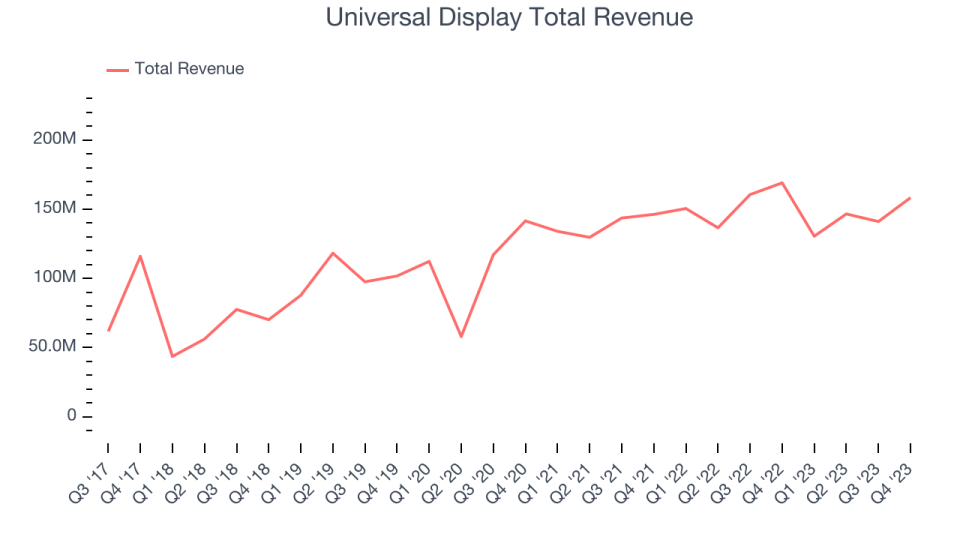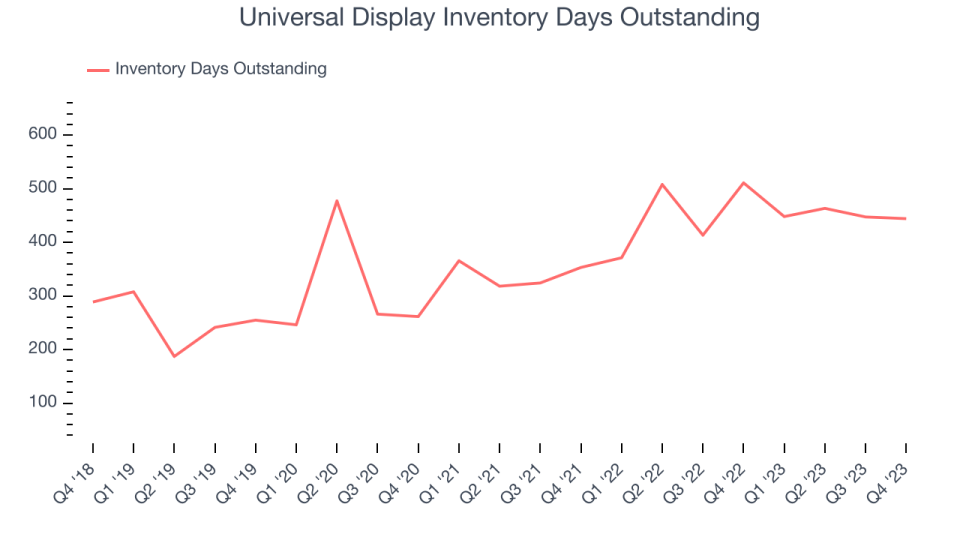Universal Display (NASDAQ:OLED) Misses Q4 Sales Targets

OLED provider Universal Display (NASDAQ:OLED) missed analysts' expectations in Q4 FY2023, with revenue down 6.3% year on year to $158.3 million. The company's full-year revenue guidance of $650 million at the midpoint also came in 2.8% below analysts' estimates. It made a GAAP profit of $1.29 per share, down from its profit of $1.36 per share in the same quarter last year.
Is now the time to buy Universal Display? Find out by accessing our full research report, it's free.
Universal Display (OLED) Q4 FY2023 Highlights:
Revenue: $158.3 million vs analyst estimates of $161 million (1.7% miss)
EPS: $1.29 vs analyst estimates of $1.15 (12.5% beat)
Management's revenue guidance for the upcoming financial year 2024 is $650 million at the midpoint, missing analyst estimates by 2.8% and implying 12.8% growth (vs -6.1% in FY2023)
Free Cash Flow of $29.49 million, down 16.6% from the previous quarter
Inventory Days Outstanding: 444, down from 447 in the previous quarter
Gross Margin (GAAP): 77.2%, down from 80.7% in the same quarter last year
Market Capitalization: $8.70 billion
“In 2023, we achieved key milestones, strengthened our capabilities and infrastructure, and positioned the Company for growth in the years ahead,” said Brian Millard, Vice President and Chief Financial Officer of Universal Display Corporation.
Serving major consumer electronics manufacturers, Universal Display (NASDAQ:OLED) is a provider of organic light emitting diode (OLED) technologies used in display and lighting applications.
Analog Semiconductors
Demand for analog chips is generally linked to the overall level of economic growth, as analog chips serve as the building blocks of most electronic goods and equipment. Unlike digital chip designers, analog chip makers tend to produce the majority of their own chips, as analog chip production does not require expensive leading edge nodes. Less dependent on major secular growth drivers, analog product cycles are much longer, often 5-7 years.
Sales Growth
Universal Display's revenue growth over the last three years has been mediocre, averaging 15.8% annually. But as you can see below, its revenue declined from $169 million in the same quarter last year to $158.3 million. Semiconductors are a cyclical industry, and long-term investors should be prepared for periods of high growth followed by periods of revenue contractions (which can sometimes offer opportune times to buy).

Universal Display had a difficult quarter as revenue dropped 6.3% year on year, missing analysts' estimates by 1.7%. This could mean that the current downcycle is deepening.
Unless you’ve been living under a rock, it should be obvious by now that generative AI is going to have a huge impact on how large corporations do business. While Nvidia and AMD are trading close to all-time highs, we prefer a lesser-known (but still profitable) semiconductor stock benefitting from the rise of AI. Click here to access our free report on our favorite semiconductor growth story.
Product Demand & Outstanding Inventory
Days Inventory Outstanding (DIO) is an important metric for chipmakers, as it reflects a business' capital intensity and the cyclical nature of semiconductor supply and demand. In a tight supply environment, inventories tend to be stable, allowing chipmakers to exert pricing power. Steadily increasing DIO can be a warning sign that demand is weak, and if inventories continue to rise, the company may have to downsize production.

This quarter, Universal Display's DIO came in at 444, which is 84 days above its five-year average. These numbers suggest that despite the recent decrease, the company's inventory levels are higher than what we've seen in the past.
Key Takeaways from Universal Display's Q4 Results
Revenue missed this quarter, although operating income beat slightly. Full-year revenue guidance missed analysts' expectations, which is a major driver of why the stock is down. Overall, this was a mediocre quarter for Universal Display. The company is down 4.2% on the results and currently trades at $179.2 per share.
Universal Display may have had a tough quarter, but does that actually create an opportunity to invest right now? When making that decision, it's important to consider its valuation, business qualities, as well as what has happened in the latest quarter. We cover that in our actionable full research report which you can read here, it's free.
